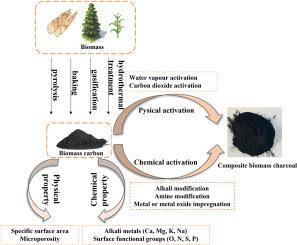A review of biomass-based carbon dioxide adsorbents research
IF 4.3
2区 材料科学
Q2 ENGINEERING, CHEMICAL
引用次数: 0
Abstract
Excessive CO2 emissions pose a severe environmental threat, driving interest in carbon capture technologies. Biomass-derived activated carbon (BAC) emerges as a promising adsorbent due to its renewable feedstocks, cost-effectiveness, and tunable properties. This review comprehensively analyzes recent advances in BAC for CO2 capture. Key findings indicate that agricultural/forestry wastes are optimal feedstocks, while alkali/alkaline earth metals and N/S-containing functional groups enhance surface alkalinity and CO2 affinity. Pyrolysis is identified as the preferred preparation method for optimizing pore structure. Physical activation (CO2, steam) and chemical modification (KOH/NaOH, amine grafting, metal oxide impregnation) significantly improve porosity and adsorption capacity. Notably, N-doping increases CO2 uptake by 31.6–55.2 %, and microporous volume (0.59–0.71 cm3/g) is critical for performance. However, challenges include high energy consumption during KOH activation, feedstock variability impacting consistency (>22 % ash content differences), competitive adsorption from flue gas impurities (>30 % capacity loss), and metal leaching risks. Future research should prioritize in-situ mechanistic studies, heteroatom co-doping, and scalable production techniques to advance industrial deployment.

生物质基二氧化碳吸附剂的研究进展
过量的二氧化碳排放对环境构成严重威胁,促使人们对碳捕获技术产生兴趣。生物质衍生活性炭(BAC)由于其可再生原料、成本效益和可调特性而成为一种有前途的吸附剂。本文综合分析了BAC用于CO2捕集的最新进展。主要研究结果表明,农业/林业废弃物是最佳的原料,而碱/碱土金属和含N/ s的官能团增强了表面碱度和CO2亲和力。热解是优化孔隙结构的首选制备方法。物理活化(CO2、蒸汽)和化学改性(KOH/NaOH、胺接枝、金属氧化物浸渍)显著提高了孔隙度和吸附能力。值得注意的是,n掺杂使CO2吸收量增加了31.6 - 55.2%,微孔体积(0.59-0.71 cm3/g)对性能至关重要。然而,挑战包括KOH活化过程中的高能耗、影响一致性的原料变化(灰分含量差异>; 22%)、烟气杂质的竞争性吸附(>; 30%容量损失)以及金属浸出风险。未来的研究应优先考虑原位机理研究、杂原子共掺杂和可扩展的生产技术,以推进工业部署。
本文章由计算机程序翻译,如有差异,请以英文原文为准。
求助全文
约1分钟内获得全文
求助全文
来源期刊

Particuology
工程技术-材料科学:综合
CiteScore
6.70
自引率
2.90%
发文量
1730
审稿时长
32 days
期刊介绍:
The word ‘particuology’ was coined to parallel the discipline for the science and technology of particles.
Particuology is an interdisciplinary journal that publishes frontier research articles and critical reviews on the discovery, formulation and engineering of particulate materials, processes and systems. It especially welcomes contributions utilising advanced theoretical, modelling and measurement methods to enable the discovery and creation of new particulate materials, and the manufacturing of functional particulate-based products, such as sensors.
Papers are handled by Thematic Editors who oversee contributions from specific subject fields. These fields are classified into: Particle Synthesis and Modification; Particle Characterization and Measurement; Granular Systems and Bulk Solids Technology; Fluidization and Particle-Fluid Systems; Aerosols; and Applications of Particle Technology.
Key topics concerning the creation and processing of particulates include:
-Modelling and simulation of particle formation, collective behaviour of particles and systems for particle production over a broad spectrum of length scales
-Mining of experimental data for particle synthesis and surface properties to facilitate the creation of new materials and processes
-Particle design and preparation including controlled response and sensing functionalities in formation, delivery systems and biological systems, etc.
-Experimental and computational methods for visualization and analysis of particulate system.
These topics are broadly relevant to the production of materials, pharmaceuticals and food, and to the conversion of energy resources to fuels and protection of the environment.
 求助内容:
求助内容: 应助结果提醒方式:
应助结果提醒方式:


